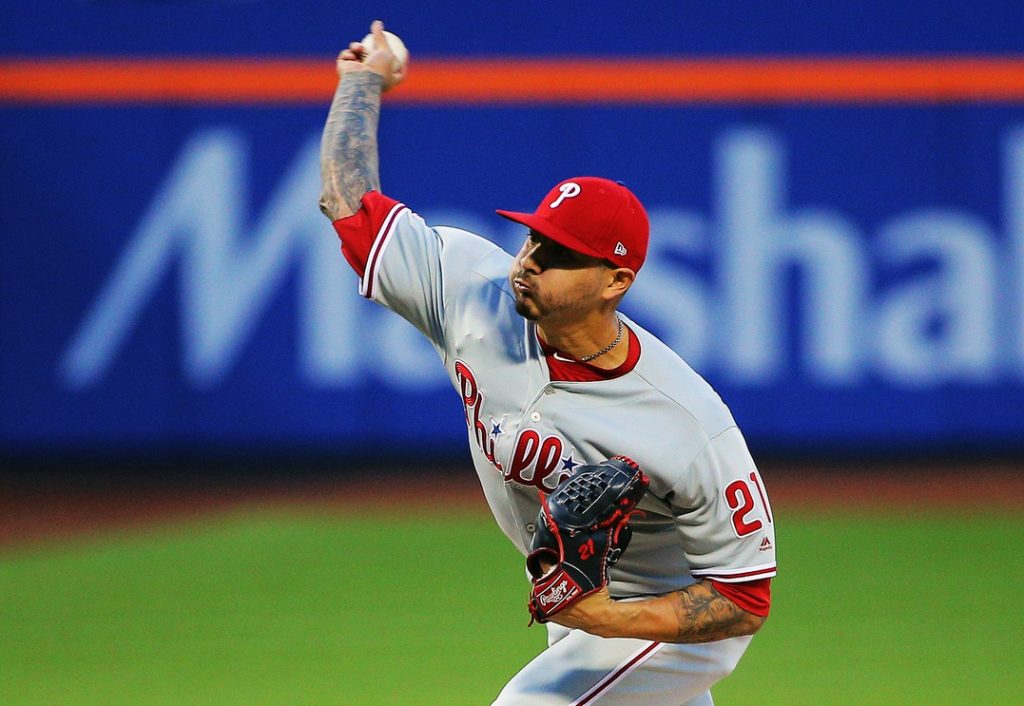Ad Disclosure
A Deeper Look at Vince Velasquez’s Solid Start
By Bob Wankel
Published:

Vince Velasquez turned in five shutout innings to help his team avoid a three-game sweep by the Mets at Citi Field last night. It was an important game for the Phillies, who desperately needed to stop the bleeding in the final game of what was a forgettable 2-5 road trip. It was also an encouraging game in that Velasquez once again gave the team a chance to win for the fourth time in as many starts. His early success has helped bring some stability to what has otherwise been an underwhelming starting rotation through the season’s first month. Consider these numbers:
| Statistic | Current Performance | NL Rank |
|---|---|---|
| ERA | 4.60 | 11th |
| FIP | 5.00 | 13th |
| WHIP | 1.44 | 12th |
| WAR | 0.7 | 13th |
As you can imagine, if you take away the 22.2 innings pitched to a 1.99 ERA by Velasquez, things get ugly. Very ugly. So good job by him to this point. Of course, whenever a player exceeds the averages of his career performance, particularly this early in the season, the question becomes whether or not such an outlier performance is sustainable. Has Velasquez finally turned the corner, or will this improved performance simply become another maddening example of what could have been? Keep in mind, this isn’t the first time he has been able to piece together a string of strong starts. Even in what was a decidedly underwhelming 2018 season, Velasquez put together a stretch from June 14 through August 3 in which he pitched to a 2.14 ERA with a 0.93 WHIP over 46.1 IP, holding opposing batters to a .155 average and .512 OPS. Then the bottom fell out. Beginning with his next start, Velasquez allowed an 8.45 ERA with a 1.85 WHIP while opponents hit .333 with a .959 OPS over his final 33 IP. It was a simply brutal stretch, one that seemed to wash away any of the positive momentum he had built last season.
So, what does this all mean for the present? I guess this doesn’t come as a shock, but it’s still way too early to say with any certainty whether or not this version of Velasquez is for real, but there are some discernible differences in his game. For one, he’s throwing harder. According to StatCast, there has been a jump in velocity in all of his offerings, which you can see after the jump.
| Pitch Type | 2018 | 2019 |
|---|---|---|
| Four-seam | 94 mph | 95 mph |
| Curve | 81.4 mph | 84.4 mph |
| Slider | 84.9 mph | 87.1 mph |
| Sinker | 92.3 mph | 93.3 mph |
Conventional wisdom typically suggests an increase in velocity will yield more swings and misses, but that actually hasn’t been the case. His Whiff% has decreased from 27.3% in ’18 to 22.5% this season. This may be a product of a relatively small sample size, but his drop in swings and misses can also be explained by an effort to become more efficient with his pitches and less fearful of contact. To that end, his 67.5% out of zone contact percentage by opposing hitters is significantly higher than his 58.3% career average, which has subsequently dropped his hard hit percentage from 34.3% last season to 27.1% so far in 2019.
The other primary difference is that he has increased his four-seam fastball usage from 54.5% last season to 64.9% this season, electing to attack hitters more frequently with his best pitch. I loved this 1-2 pitch to Wilson Ramos with runners on first and third and only one out. Velasquez could’ve elected to get cute here, but he went right after Ramos with the fastball and overpowered him up in the zone at 95 mph.
Nasty.
Velasquez has also relied more on his slider this season (18.5%) than he did in 2018 (15.5%), while using his curveball and sinker less. He has also effectively eliminated from his repertoire what had been a below-average changeup. That has been a good game plan in the early going. Opposing batters are hitting only .200 against his fastball so far, and it should go without saying that anytime a pitcher can increase the usage of a pitch hitters struggle with, that’s going to produce better overall results. Not exactly advanced stuff here. Incidentally, Velasquez has also had more success so far with his curveball thanks to its decreased usage.
So, this is all really good, and totally sustainable, right? We’ll see, but there are some potential red flags. According to StatCast, both the expected batting average and expected slugging percentage against his fastball, slider, and curveball are higher than they were a season ago, and he has gotten away with some center-cut mistakes, which would suggest there has been an element of luck at play.
Ultimately, it’s only been four starts, but baseball is a game where sometimes rhythm and confidence can’t be quantified and he seems to be in a good spot right now. It’s also a realistic possibility that as Velasquez continues to adjust to this new approach he gains even more command and comfort, yielding consistently sustainable results. If nothing else, Velasquez has provided some stability during a period in which Aaron Nola has struggled and Nick Pivetta basically blew up, showing that he is more than capable of turning in quality performances at the back-end of the Phillies rotation. For now, that should be enough to feel good about.
Bob Wankel covers the Phillies for Crossing Broad. He is also the Vice President of Sports Betting Content at SportRadar. On Twitter: @Bob_Wankel E-mail: b.wankel@sportradar.com